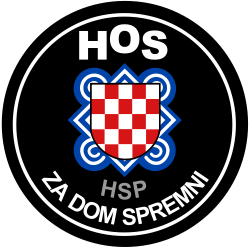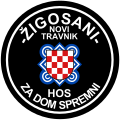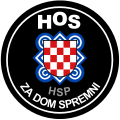| Croatian Defence Forces Hrvatske obrambene snage | |
|---|---|
 Patch of the Croatian Defence Forces | |
| Active | 22 January 1991 – 5 April 1993 |
| Disbanded | September 1991 (Croatia) 21 August 1992 (Bosnia and Herzegovina) |
| Country | |
| Allegiance | Croatian Party of Rights |
| Branch | Army |
| Size | 8,000 [1] – 24,000 [2] |
| Headquarters | Zagreb, Croatia Ljubuški, Bosnia and Herzegovina |
| Nickname | Blacks (Crnci) |
| Motto | Za dom spremni [3] |
| Colors | Black |
| March | Himna HOS-a [4] |
| Engagements | Battle of the Barracks Battle of Gospić Siege of Slunj Battle of Vukovar Siege of Dubrovnik Siege of Mostar Battle of Kupres (1992) Battle of Posavina Attack on Piperi Siege of Sarajevo Siege of Kotor Varoš |
| Commanders | |
| Notable commanders | Dobroslav Paraga Blaž Kraljević |
| Insignia | |
| Flag |  |
The Croatian Defence Forces (Croatian : Hrvatske obrambene snage or HOS) were the paramilitary arm of the Croatian Party of Rights (HSP) from 1991 to 1992, during the first stages of the Yugoslav wars. During the Croatian War of Independence, the HOS organised several early companies and participated in Croatia's defence. At the peak of the war in Croatia, the HOS was several battalions in size. The first HOS units were headed by Ante Paradžik, an HSP member who was killed by Croatian police in September 1991. After the November 1991 general mobilisation in Croatia and the January 1992 cease-fire, the HOS was absorbed by the Croatian Army.
Contents
The HOS units in Bosnia and Herzegovina consisted of Croats, Bosnian Muslims and foreign volunteers led by Blaž Kraljević. [5] On 9 August 1992, Kraljević and eight staff members were assassinated by Croatian Defence Council (HVO) soldiers under the command of Mladen Naletilić. [6] The HOS was disbanded shortly afterwards, with its remaining military assets absorbed by the HVO and the Army of the Republic of Bosnia and Herzegovina at the beginning of the Croat-Bosniak War. [5] The last HOS unit was dissolved on 5 April 1993 in central Bosnia. [7]














